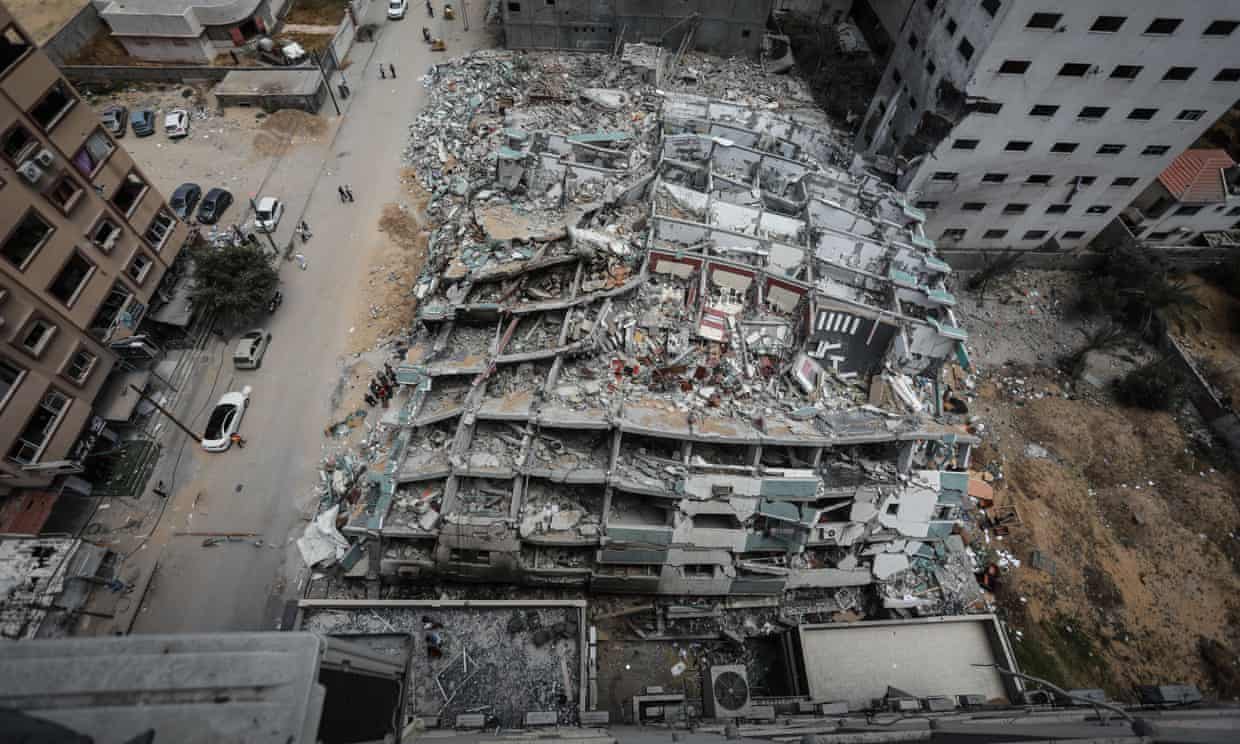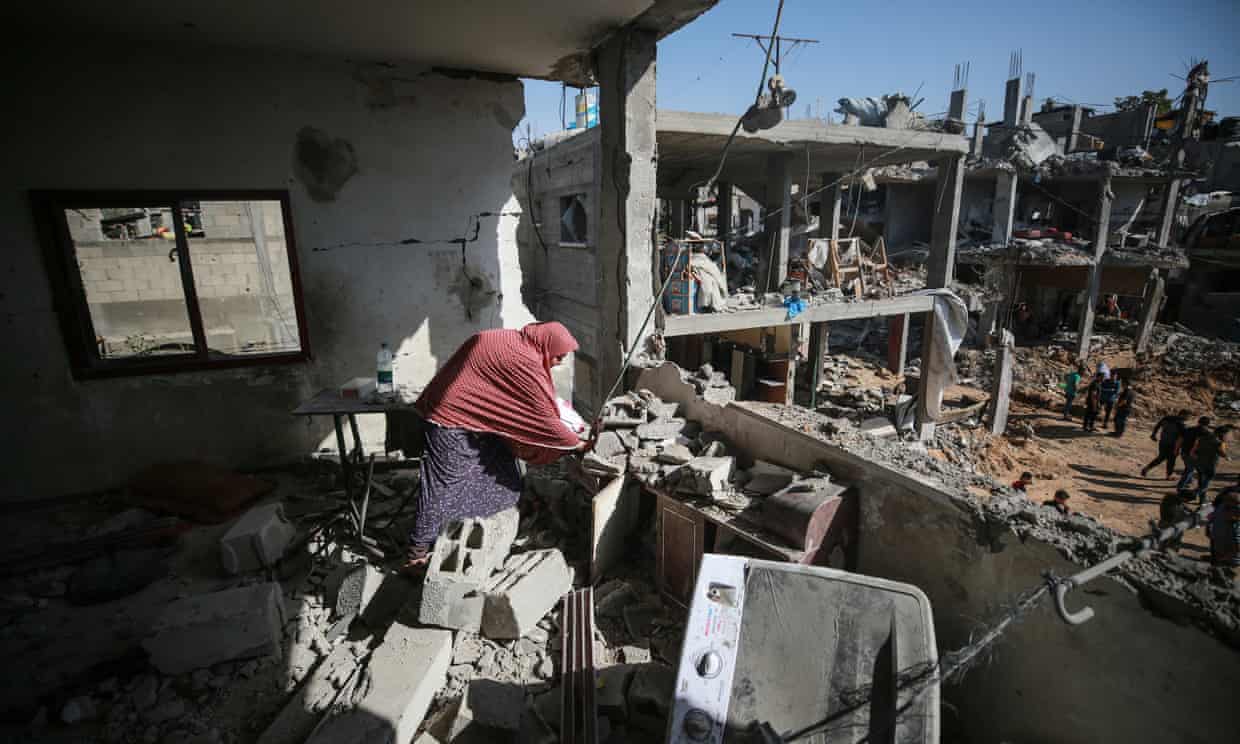Nearly a week after the attack, large mounds of concrete still lined the road. A seven-storey building that survived stood at an ominous angle, as men quickly removed wooden furniture from the ground floor. Further up al-Wehda stood a giant pile of debris that once housed the Murtajas’ apartment. Amid the dust were twisted plastic water tanks, a washing liquid bottle, pillows and a frying pan. All that remained was a three-storey-high internal staircase at the back. A sign has been erected with the names of the dead and “Al-Wehda massacre” written on it in Arabic.
A yellow taxi pulled up, and a woman got out with her teenage son. She said her name was Zakia Abu Dayer, 44, and she lived in the next building. It was the first time she had been back, she said, to collect some belongings.
On the night of the bombing, as the Murtajas were trapped under the rubble, Abu Dayer, her husband and her son moved further up the street to a relative’s home. They thought they would be more secure there as it was on the ground floor, possibly allowing them to rush outside quickly.
But two days later, she and other family members were eating rice and lentils outside when another strike hit. “There is no safe space,” she said, her leg still wrapped in bandages. “The whole place went black.”
Abu Dayer remembers smoke and then rushing water as the tanks on the building above exploded in the blast. Her husband, who was a few metres away from her, was killed after shrapnel hit his head. An 11-year-old relative was also killed.
The building that was hit still stands, although its windows were blown out. The ground floor was a bank with two ATMs covered in dust. A dental clinic sits on the first floor. Several local charities operated there. Higher up, a box with “US AID” written on it is visible through the smashed glass.
Across the road stands the damaged shell of another building. “It’s a very old primary health clinic, maybe the oldest in Gaza,” said Abdel-Latif al-Hajj, director-general of international cooperation at the ministry of health in Gaza, who stood by the gate.
At first glance, the clinic appears to have been bombed, with large pockmarks across its walls and football-sized bits of debris covering the ground. However, it was not hit directly. Instead, when the Israeli missile struck the building across the road, it ripped off the top two floors, which then slammed into the clinic.
Al-Hajj said the building was Gaza’s main testing centre for Covid. Staff had been working inside during the explosion, and several were wounded. Gaza was already suffering a dangerous spread in infections, and another outbreak is expected, he said.
“Anyone can imagine what will happen if we stop doing tests,” said al-Hajj. In addition, the war had meant thousands of displaced people were now crowded together, which could speed up transmission.
According to the United Nations, the violence on Gaza has destroyed nearly 260 buildings. Fifty-three schools, six hospitals and 11 primary healthcare centres have been damaged. Nearly 80,000 people were internally displaced, and 10 times that number have little access to piped water. As well as Israeli strikes, armed groups have launched faulty rockets that landed short, with reports of extensive damage and even fatalities within Gaza.
The strip’s two million inhabitants already live inside what they call the “world’s largest prison”, with more than 50% unemployment, a collapsed healthcare system, sometimes-poisonous water, and relentless power cuts.
Palestinians enjoy the beach as the ceasefire came into effect on 21 May in Gaza City. Photograph: Fatima Shbair/Getty Images
Israel and Egypt, Gaza’s other neighbour, have maintained a crippling blockade, locals say “siege”, for 14 years. Israel, which recalled its forces occupying the area in 2005, says the restrictions are for its security. But the UN says the blockade constitutes collective punishment.
At the damaged clinic on al-Wehda Street on Saturday, Lynn Hastings, the UN’s deputy special coordinator for the Middle East peace process, had come to assess the impact.
Flanked by aides and bodyguards, she was asked by a television reporter if this round of violence might, unlike the previous three wars, spur significant political change.
“Everyone is saying it should not be business as usual,” she responded. “You know what the definition of insanity is,” she added rhetorically. She was referring to a quote usually attributed to Einstein, that insanity is doing the same thing over and over again and expecting a different result.
Friday’s ceasefire brought some Palestinians and Israelis hope that the violence would spur a renewed push to resolve the crisis. Hamas kicked off this round of fighting when it launched rockets at Jerusalem on 10 May, but it followed weeks of growing frustrations over the treatment of Palestinians by Israel, which has for decades dictated how millions live their lives.
The head of Oxfam in Israel and the Palestinian territories, Shane Stevenson, said the truce should not be celebrated as a solution. Israel should be held to account “for the atrocities it has committed over the last 12 days”, as should armed factions in Gaza for their indiscriminate targeting of Israeli towns and cities.
The truce, he added, “will not change the illegal occupation and denial of human rights which Palestinians are subjected to daily. This inhumane and brutal status quo has to change, once and for all.”
Lying in Shifa hospital, Amjed Murtaja had less ambitious reasons to be happy. Despite his exhaustion and injures, he had stayed up late on Thursday as rumours of a ceasefire circulated. He had been waiting for the ceasefire announcement, he said, “because I don’t want to lose the rest of my family”.
===================================================================
 Saturday, July 31, 2021 at 04:19PM
Saturday, July 31, 2021 at 04:19PM 

 APJP |
APJP |  Post a Comment |
Post a Comment | 

